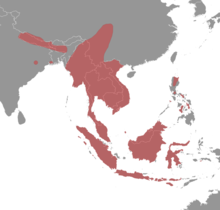Wall-roosting mouse-eared bat
| Wall-roosting mouse-eared bat | |
|---|---|

| |
| from Kuningan, West Java | |
| Scientific classification | |
| Domain: | Eukaryota |
| Kingdom: | Animalia |
| Phylum: | Chordata |
| Class: | Mammalia |
| Order: | Chiroptera |
| Family: | Vespertilionidae |
| Genus: | Myotis |
| Species: | M. muricola
|
| Binomial name | |
| Myotis muricola (Gray, 1846)
| |

| |
The wall-roosting mouse-eared bat, or Nepalese whiskered myotis (Myotis muricola) is a species of
Taxonomic notes
Myotis muricola was previously classified as a subspecies of .
Morphology
The upper side of M.muricola is coloured brown or grey with dark bases and the underside has dark bases and light brown tips. The ears are moderately long, slender, bent forwards and bluntly pointed (Francis, 2008). M.muricola has small feet with wing membranes attached at the base of the toes. The tail is long and completely enclosed in the interfemoral membrane. It has three pairs of premolars, with the upper canine much longer than the third premolar. The second premolar is small and slightly intruded from the tooth row (Yasuma, Andau, Apin, Tuh Yit Yu, & Kimsui, 2003).
Distributions
Myotis muricola is found in Afghanistan, Bangladesh, Bhutan, Cambodia, India, Indonesia, Laos, Malaysia, Myanmar, Nepal, Pakistan, Papua New Guinea, the Philippines, Thailand, and Vietnam (Simmons, 2005).
Ecology
Myotis muricola is a nocturnal and insectivorous bat. It tends to feed during the first two hours after sunset and before dawn, using ultrasonic
Habitat
Myotis muricola roosts in a variety of different sites, including curled-up banana leaves (Francis, 2008), limestone forests (Abdullah, Azlan, & Neuchlos, 2005), hollow trees, rock shelters, artificial caves, mines and tunnels, and old buildings (Richardson, 1993).
Conservation status
According to the 2019
References
- ^ . Retrieved 17 November 2021.
- Abdullah, M.T.; Azlan, Mohd; Neuchlos, J. (2005). "Diversity of Chiropterans in limestone forest area, Bau, Sarawak". Malays. Appl. Biol. 34 (1): 59–64.
- Bonaccooso, F.J. (1998). Bats of Papua New Guinea. Washington DC: Conservation International.
- Cooper KL, Tabin CJ (January 2008). "Understanding of bat wing evolution takes flight". Genes Dev. 22 (2): 121–4. PMID 18198331.
- Francis, C.M., Guillén, A., Robinson, M.F. (1999). Order Chiroptera: Bats. Wildlife of Lao PDR: 1999 Status Report .
- Khan, M.M. (1992). Mamalia Semenanjung Malaysia (in Malay). OCLC 34640593.
- Payne, J.; Francis, C.M.; Phillipps, K. (1994). A Field guide to the Mammals of Borneo. Petaling Jaya: The Sabah Society.
- Richardson, P. (1993). Bats. London: Whittet Books.
- Sears KE, Behringer RR, Rasweiler JJ, Niswander LA (2006). "Development of bat flight: morphologic and molecular evolution of bat wing digits". Proc. Natl. Acad. Sci. 103 (17): 6581–6. PMID 16618938.
- Simmons, N.B. (2005). "Order Chiroptera". In Wilson, D.E.; Reeder, D.M. (eds.). Mammal species of the World: a taxonomic and geographic reference (3rd ed.). Johns Hopkins University Press.
- Yasuma, S.; Andau, M.; Apin, L.; Tuh Yit Yu, F.; Kimsui, L. (2003). Identification keys to the mammals of Borneo. Sabah: BBEC Publication.

